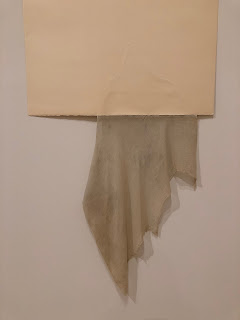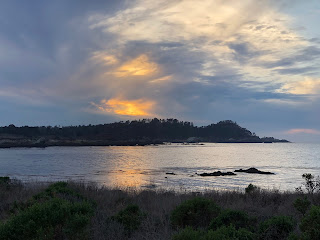 |
| Retroactive II (1964) |
I've seen Robert Rauschenberg's work before—I know I have. I think of silkscreened photos of astronauts and JFK, overlain by rectangular blocks of solid paint, artistic-political statements evoking the adventurousness and turmoil of the 1960s. But when I scroll through Google images, no single painting jumps out, as in, "Aha, yes, I have seen that one before!" And indeed, there's way (way) more variety in his imagery than I had ever imagined. Maybe I just know his
name, and lump him in with those post-expressionist/pop artists like Andy Warhol, Jasper Johns, Jackson Pollock, Roy Liechtenstein, and leave it at that? Who knows.
 |
At Gemini G.E.L.,
Los Angeles,1969 |
In any event, today I was schooled in the genius of Robert Rauschenberg (1925– 2008)—the first American artist to win the Golden Lion at the Venice Biennale, in 1964—through a fabulous show called
"Erasing the Rules" at SFMOMA, which brings together 170 of his works from early in his career in the early 1950s until the end of his life. A pivotal figure in the history of American art, he pushed back at the abstract expressionists and helped give rise to pop art.
One thing that marked his career was a negotiation between the "retinal"—the visual pleasures of tone, color, and subtle detail, which the abstract expressionists spurned—and the conceptual. Another is his exuberant experimentation with the material bases of art, whether paint or pencil, metal or silkscreen; fabric in the form of printers' rags, bedsheets, socks and t-shirts, or beautiful blocks of silk; or the stuff of the cultural world, such as newspapers and magazine photos, which he collaged into multi-layered works of both personal and social commentary.
 |
Untitled (Hotel Bilbao),
ca. 1952 |
The fact that so much of his work
is collage means that you
have to see it in person. Sure, that's true of any work of art. But collage holds surprises. He started with simple assemblages from travels in Europe with fellow artist (and, for a time, lover) Cy Twombly. And he continued to experiment, becoming ever more exuberant, irreverent, and radiant.
 |
Monogram, 1959
|
And then there's the stuffed Angora goat that he encircled with a car tire, which stands on top of reinterpreted
Life magazine photographs.
Rauschenberg studied with Josef Albers at Black Mountain College, where he met composer John Cage and choreographer Merce Cunningham and other early innovators, with whom he continued to collaborate and share ideas. Jasper Johns, another lover, was also a close influence.
I won't outline his entire life, but let's just say, I was very moved and inspired by the various turns he took in his approach to his art, by his wild inventiveness, by his productivity and the diversity of his pieces. This man did not stand still, but constantly challenged the very identity of "art" and his own relationship to it.
Here are a few photos I took today. There are probably better images online, but... these are handy. And mine. With some of them, I even took note of their titles and a few details... (As always, click on the images to see them large on black.)
 |
| One of the Red paintings, 1953–54 (detail) |
 |
Untitled, 1958
Handkerchief, safety pins, chain necklaces,
paint, and pants |
 |
Gift for Apollo, 1959
Oil, fragments of pants, necktie, wood, fabric, newspaper, printed
paper, and printed reproductions on wood with metal bucket,
chain, doorknob, L-brackets, metal washer, nail, cement, and
rubber wheels with metal spokes.
This would be an example of what he called "combines" | |
 |
Autobiography, 1968
16.5 feet high x 4 feet wide |
 |
Rosalie/Red Cheek/Temporary Letter/Stock (Cardboard), 1971
One of the earliest works of the Cardboard series, this piece embodies
Rauschenberg's transition from NYC to Captiva Island, Forida. The
use of cardboard, which he described as "a materials of waste and
softness," marked both a radical departure from the glass, metal,
and electronics of his preceding, technological works and a
continuation of his long-held interest in impermanence, variability,
and the subversive potential of mundane materials. |
|
 |
On the far wall are dirty printers' rags that RR placed
between two pieces of printing paper and passed through a
press. Below is a close-up. I loved the way the end of the
rag is outlined in the pressed paper (below). |
|
 |
Mirage (Jammer), 1975
Part of a series of what he called "jammers," employing
silk he brought from India, thread, sometimes some
wood, or even metal teapots
|
 |
Hiccups, 1978
Solvent transfer and fabric with metal zippers on
handmade paper
"Here snippets of ribbon and fabric intermingle with transfer
images from popular magazines featuring maps, animals,
landscapes, and athletes. The string of colors and pictures
that reels out across the wall is playful and endlessly variable,
as the ninety-seven panels can be unzipped and recombined in any
order each time they are installed. Expansive, improvisational,
and calling for time to view and absorb, Hiccups can be seen as
an extension of Rauschenberg's early interest in
performance."
I loved these images, so I'm going to bore you with a few
semi–close-ups. I'd like to go back and spend more
time with this piece.
|
 |
Alas, I did not record the names of the pieces shown
here and in the next photo. |
 |
| Except for Untitled (Spread), 1963 (detail below) |
 |
Drawing for Dante's 700th Birthday, 1965
Watercolor and gouache on board with silkscreen ink
"This later tribute to Dante [following a set of illustrations of
the Inferno] boils with images of civil unrest, racist posters,
Holocaust victims, and war-ravaged landscapes.... Life
published them under the title 'A Modern Inferno,' calling
out the two astronaut figures that 'stand apart from the earth
like detached witnesses, observing the accelerating force
of dehumanizing machines and the bestiality that threatens
to destroy man.'"
I found this piece incredibly moving, considering that now,
a little over fifty years later, so little seems to have changed... |
|




















































